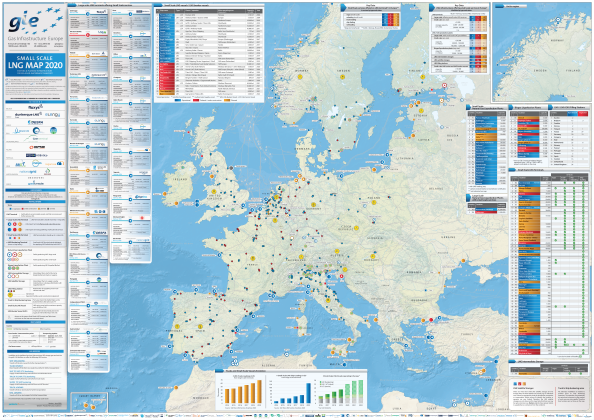
GIE (Gas Infrastructure Europe), the association representing European operators of gas transportation infrastructures, storage and regasification of LNG, also active in the small scale LNG sector, has communicated the publication of the map updated on 15 June 2020 regarding services for the direct use of liquid methane.
Although sometimes ConferenzaGNL has found slight differences in the past, always lacking, compared to some data, especially on road service stations, nevertheless the new map provides an updated overview of the growing trend of the infrastructures available, planned and announced in Europe .
GIE informs that the display has also been improved to make readability even more intuitive. The Association reports that the small scale LNG continues to develop strongly throughout Europe, both as a fuel in maritime and heavy road transport and as an off-grid energy solution.
The trend of strong growth was confirmed for road transport. GIE reviews 280 LNG filling stations, while the milestone of the 200th station was reached only a year ago.
For ship bunkering, the progress is even more surprising, says the association: there are now 9 ships dedicated to LNG bunkering, with another 5 that should be delivered by the end of 2020, while three years ago there were only 2.
The supply of industrial sites not connected to the gas network is another expanding use of LNG on a small scale, as well as to communities not connected to a pipeline network.
New projects for small-scale LNG terminals and liquefaction plants are being developed in more and more countries. A further step forward for the energy transition is represented by the development of liquid biomethane production plants in various European countries (Norway, Sweden, United Kingdom, Finland, Italy ...).
All the small scale LNG infrastructures are "ready for carbon neutrality": they can immediately manage, without any limitation, liquid biomethane (as is already happening) or synthetic methane (ie green hydrogen methane) or can adapt to other neutral carbon molecules.
Arno Büx, president of GIE said: “In order to support its development, GIE continuously provides updated information on the state and use of the European LNG infrastructure. With the publication of the small-scale LNG map GIE in 2020, GIE confirms its commitment to providing information, skills and transparency tools to the European institutions, regulatory bodies, the market and all other interested parties. The rapid growth of small-scale LNG illustrates its potential to pave the way for a greener energy future."
Source: Press release
 EN
EN  it
it

